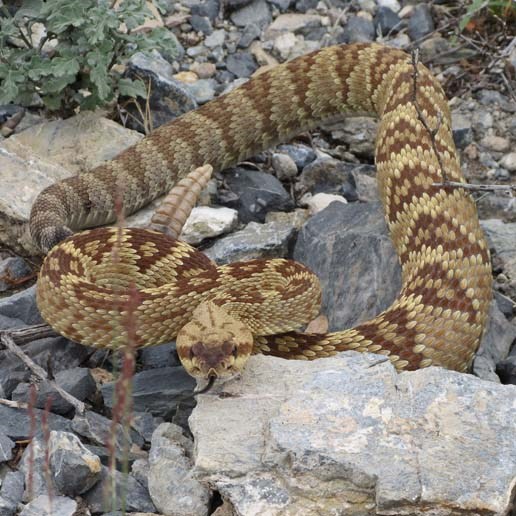
What can you do to help protect rattlesnakes? Do not harm a rattlesnake when found in the park. Allow the rattlesnake to continue as it was and observe from a safe distance. Always watch where you place your hands and feet, taking extra caution when climbing or walking among rocks and deep grass. Because rattlesnakes are venomous, visitors should educate themselves on identification and precautions. Snakes are most active in the park April through October. They are typically active early morning, late afternoon and at night. If you discover you’re sharing the same space with a rattlesnake, it is your behavior and actions that determine how the encounter goes. To avoid conflict with rattlesnakes, leave them alone. Don’t panic, respect the snake’s personal space, don’t try to hassle it or pick it up, and move slowly to a safe distance. Never handle a rattlesnake, even after it is dead. A rattlesnake head can still bite several hours after its death! Rattlesnakes are only dangerous to people when people fail to respect the snake's personal space. Rattlesnakes typically strike at humans when they feel threatened by them. Most bites occur when a person provokes a snake by either accidently stepping on one or purposely trying to capture, harass or kill the animal. Keep in mind that the snake wants nothing to do with you. It will only strike if it feels threatened. Lightning strikes pose a much greater threat to humans than rattlesnakes do. If a bite does occur, seek medical treatment as soon as possible. Immobilize the bite area, gently wash the area with soap and water, and keep it lower than the heart. If possible, stay put to avoid moving the muscle. Remove any jewelry that might constrict swelling. Do not cut the wound with a knife, put ice on the bite area, attempt to suck the venom out, or constrict circulation to the limb. Facts About the RattlesnakeRattlesnakes have a triangular head, narrow neck, and vertical pupils. They are typically two to six feet long. They can rattle 20-100 times per second, but rarely do, in order to remain still and avoid being seen. Rattlesnakes are classified as "pit vipers" because they have a pair of heat sensitive pits just below their nostrils, allowing them to sense warm-blooded prey by its body heat. Using hollow, needle-like fangs that fold out when the mouth opens, rattlesnakes inject venom in split-second contact with prey, or an animal or human that poses a direct threat to the snake. The fangs have venom ducts that connect to glands under their back jaws. These jaws are connected with ligaments only, allowing them to stretch greatly around prey. Rattlesnakes are extremely sensitive to chemical cues. Their long, forked tongues, which they stick out to pick up scents, transmit odors to receptors in what is called a "Jacobson's organ" at the roof of their mouths, allowing the snakes to follow odor trails of envenomed prey. Rattlesnakes don't have ears but they can pick up, or feel, vibrations. Very familiar with their home ranges, rattlesnakes have favorite spots for hunting, resting, nesting, and return over and over again to places where they were born, where they have given birth and even places they have mated in the past. Rattlesnakes are ambush hunters. They stake out a spot and wait until prey comes close enough to strike, which is about one third to one half their body length. They do not stalk prey, except to follow the scent trails of envenomed prey. Males will follow scent trails of females, with mating on their minds. If two males come upon a female, they will fight over her, wrestling with each other, until the stronger one throws down the other. They don't bite or injure each other, but will continue to wrestle until the weaker snake backs down. Rattlesnakes have elaborate courtship rituals but only about 10 percent of these will result in copulation. A pair of courting rattlers can mate up to 12 hours at a time. A mother rattlesnake gives birth to live young during the monsoon season. A recent study of black-tailed rattlesnakes in the Chiricahua Mountains revealed mother rattlesnakes remain with their babies after birth for about 10 days, until the young snakes shed their first skin and are better able to defend themselves. There are 13 types of rattlesnakes in Arizona, nine of which can be seen here in Cochise County. The most commonly seen are the Western Diamondback, Mojave, and Black-Tailed.
|
Last updated: July 27, 2018
